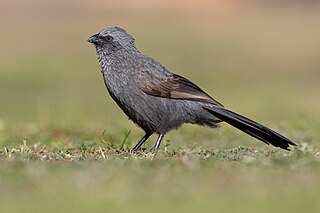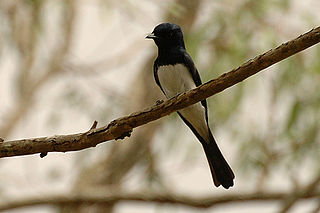
The Australian magpie is a black and white passerine bird native to Australia and southern New Guinea, and introduced to New Zealand. Although once considered to be three separate species, it is now considered to be one, with nine recognised subspecies. A member of the Artamidae, the Australian magpie is placed in its own genus Gymnorhina and is most closely related to the black butcherbird. It is not closely related to the European magpie, which is a corvid.

The cuckoo, common cuckoo, European cuckoo or Eurasian cuckoo is a member of the cuckoo order of birds, Cuculiformes, which includes the roadrunners, the anis and the coucals.

The willie wagtail, scientific name Rhipidura leucophrys, is a passerine bird native to Australia, New Guinea, the Solomon Islands, the Bismarck Archipelago, and Eastern Indonesia. It is a common and familiar bird throughout much of its range, living in most habitats apart from thick forest. Measuring 19–21.5 cm in length, the willie wagtail is contrastingly coloured with almost entirely black upperparts and white underparts; the male and female have similar plumage.

The pied currawong is a black passerine bird native to eastern Australia and Lord Howe Island. One of three currawong species in the genus Strepera, it is closely related to the butcherbirds and Australian magpie of the family Artamidae. Six subspecies are recognised. It is a robust crowlike bird averaging around 48 cm (19 in) in length, black or sooty grey-black in plumage with white undertail and wing patches, yellow irises, and a heavy bill. The male and female are similar in appearance. Known for its melodious calls, the species' name currawong is believed to be of indigenous origin.

The European pied flycatcher is a small passerine bird in the Old World flycatcher family. One of the four species of Western Palearctic black-and-white flycatchers, it hybridizes to a limited extent with the collared flycatcher. It breeds in most of Europe and across the Western Palearctic. It is migratory, wintering mainly in tropical Africa. It usually builds its nests in holes on oak trees. This species practices polygyny, usually bigamy, with the male travelling large distances to acquire a second mate. The male will mate with the secondary female and then return to the primary female in order to help with aspects of child rearing, such as feeding.
Pee Wee or Peewee may refer to:

The monarchs comprise a family of over 100 passerine birds which includes shrikebills, paradise flycatchers, and magpie-larks.

The paradise flycatchers (Terpsiphone) are a genus of birds in the family Monarchidae. The genus ranges across Africa and Asia, as well as a number of islands. A few species are migratory, but the majority are resident. The most telling characteristic of the genus is the long tail streamers of the males of many species. In addition to the long tails the males and females are sexually dimorphic and have rufous, black and white plumage.

The apostlebird, also known as the grey jumper, lousy jack or happy family, is a quick-moving, gray or black bird about 33 cm (13 in) long. It is a native to Australia where it roams woodlands, eating insects and seeds at, or near, ground level. Apostlebirds often travel in groups of about 12; for this reason, they were named after the 12 Biblical apostles.

The pied butcherbird is a songbird native to Australia. Described by John Gould in 1837, it is a black and white bird 28 to 32 cm long with a long hooked bill. Its head and throat are black, making a distinctive hood; the mantle and much of the tail and wings are also black. The neck, underparts and outer wing feathers are white. The juvenile and immature birds are predominantly brown and white. As they mature their brown feathers are replaced by black feathers. There are two recognised subspecies of pied butcherbird.

The grey butcherbird is a widely distributed species endemic to Australia. It occurs in a range of different habitats including arid, semi-arid and temperate zones. It is found across southern Australia, but is absent from the deserts of central Australia and the monsoon tropics of northern Australia. It has a characteristic rollicking birdsong. It appears to be adapting well to city living, and can be encountered in the suburbs of many Australian cities including Brisbane, Melbourne, Perth and Sydney. The grey butcherbird preys on small vertebrates including other birds.

The Australian rufous fantail is a small passerine bird, most commonly known also as the black-breasted rufous-fantail or rufous-fronted fantail, which can be found in Australia.

The eastern whipbird is an insectivorous passerine bird native to the east coast of Australia. Its whip-crack song is a familiar sound in forests of eastern Australia. Two subspecies are recognised. Heard much more often than seen, it is dark olive-green and black in colour with a distinctive white cheek patch and a crest. The male and female are similar in plumage.

The dusky woodswallow is a bird species of forests and woodlands in temperate and subtropical regions, extending into tropical areas around the Atherton Tableland, in eastern and southern Australia. The global population of the species has as yet not been formally confirmed, but it has been officially rated in the range of 'Least Concern', according to the BirdLife International in 2004. As such, the bird could be described as common in its local habitat.

Grallina is a genus of passerine bird native to Australia and New Guinea. It is a member of a group of birds termed monarch flycatchers.

The satin flycatcher is a species of bird in the family Monarchidae. Males stand out with their blue-black feathers contrasting their white bellies, and the females with their bright orange throats. It breeds mostly in south-eastern Tasmania and Australia. It is declining throughout the eastern seaboard due to predation from the introduced Red Fox and habitat loss. It is a vagrant to New Zealand.

























